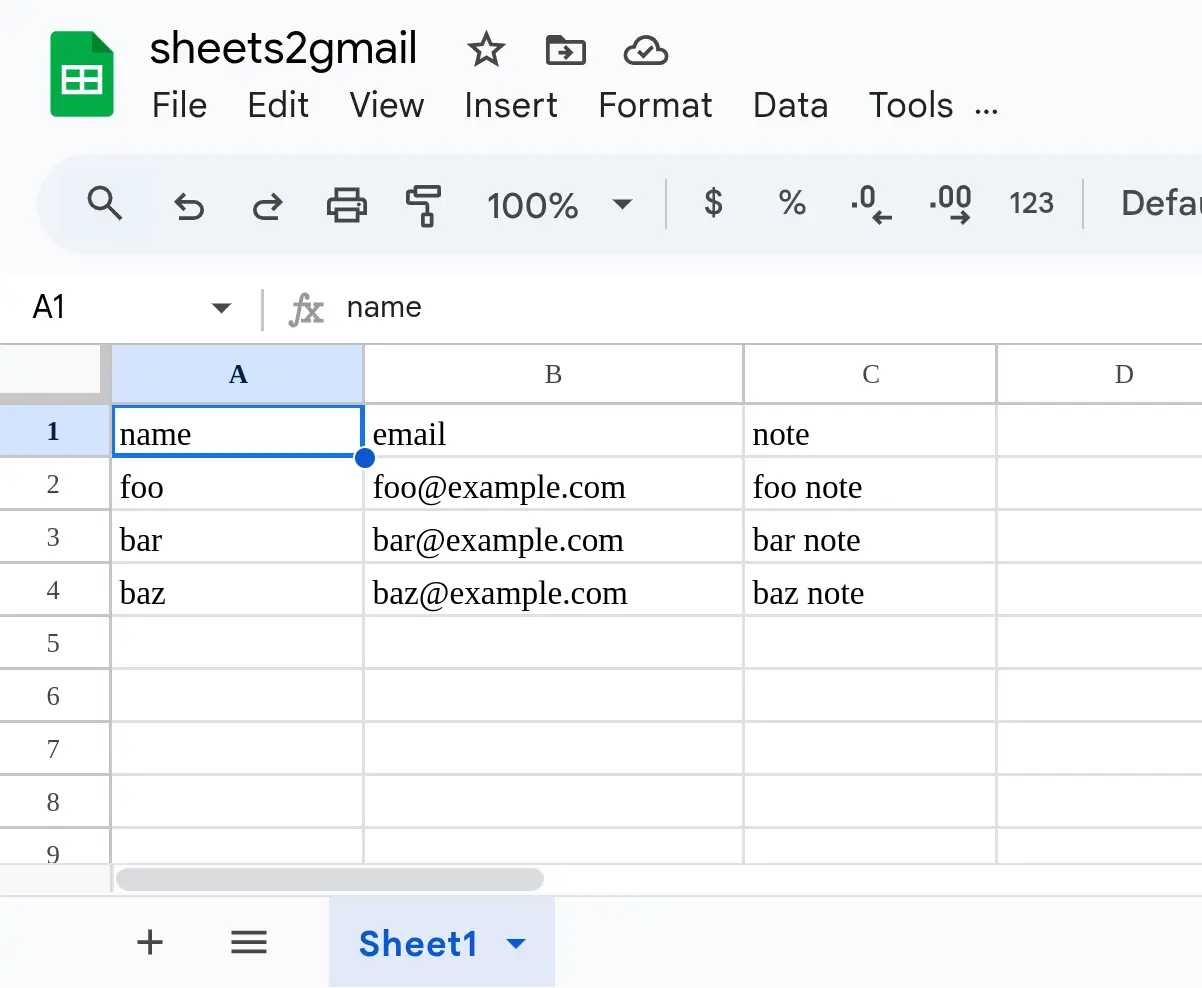My first Zapier Zap: Send emails via Gmail when Google Sheets rows are updated (part 2)
You're reading part 2 of My first Zapier Zap: Send emails via Gmail when Google Sheets rows are updated series, where I built an automation that send emails via Gmail when Google Sheets rows are updated:
-
Check out Part 1 to see how I built and publish this automation using Zapier Zap with the Zap editor.
Once I got my first Zap working I wanted to try doing the same thing in Python using Google APIs.
In Zapier, I noticed that the trigger I chose was
specified as instant. I
wondered how Zapier managed to detect spreadsheet changes so fast.
My first thought was to look for push notifications in the Google
Sheets API. There isn't.
Google Sheets API doesn't offer such a service.
Then, I remembered that when I authenticated and authorized Zapier for triggering on row changes, I had to give access not just to Google Sheets, but also to Google Drive. Now I understood why. The Google Drive API does offer push notifications. I suspect this is how Zapier gets notified instantly.
But to start, I wanted to stick with just the Google Sheets API and Gmail API.
So I opted for a polling script that checks the spreadsheet for changes from time to time.
I ended up writing the sheets2gmail_polling.py script, which works like this:
-
Every
POLLING_INTERVALseconds, it retrieves the rows inSHEET_NAMEfromSPREADSHEET_ID(the string between/d/and/editin the URL likehttps://docs.google.com/spreadsheets/d/<id>/edit). -
Then, it checks which rows are new or have been updated by comparing their hashes (using the
row_hashfunction) to the ones stored in thecached_rowstable of thecache.sqlite3database. This is done bycheck_rows. -
Then, for every new or updated row found, it updates the cache in an atomic operation (updating
cached_rowsand queuing emails to be sent in thepending_emailstable). This is done byupdate_cache. -
Finally, it sends all the queued emails in
pending_emails. If an email fails to send three times, it won't try to send it again when the script detects updates or is restarted. This is done bysend_emails.
Here's the
main function:
def main():
conn = setup_cache_db(CACHE_DB_FILE)
creds = credentials()
# In case the program previously stopped before sending all the emails
send_emails(conn, creds, FROM_ADDR)
while True:
rows = get_rows(creds, SPREADSHEET_ID, SHEET_NAME)
if not rows or len(rows) == 1:
logger.info(f"No data in spreadsheet {SPREADSHEET_ID}, range {SHEET_NAME}")
else:
new_updated_rows = check_rows(conn, rows)
update_cache(conn, new_updated_rows, len(rows))
send_emails(conn, creds, FROM_ADDR)
time.sleep(POLLING_INTERVAL)
conn.close()Setting up the sheets2gmail project in the Google Cloud console
In the Google Cloud console:
-
I created the project
sheets2gmail: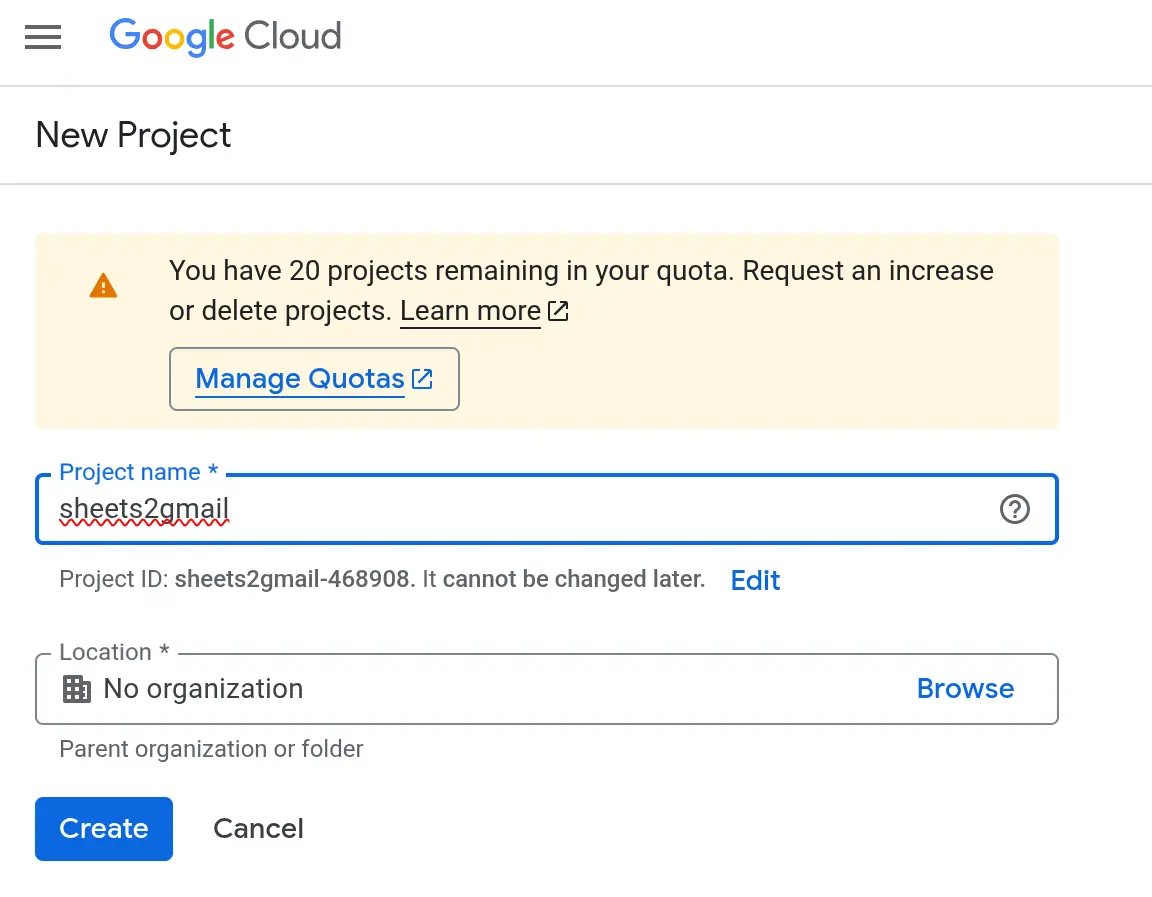
-
In that project, I enabled both the Google Sheets API and the Gmail API:
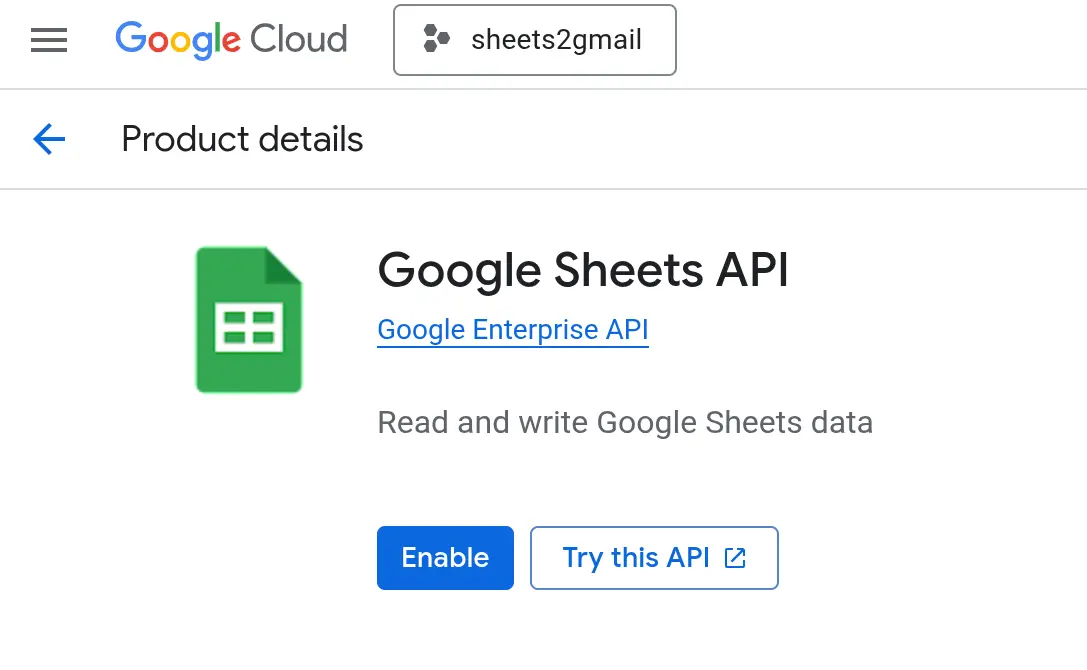
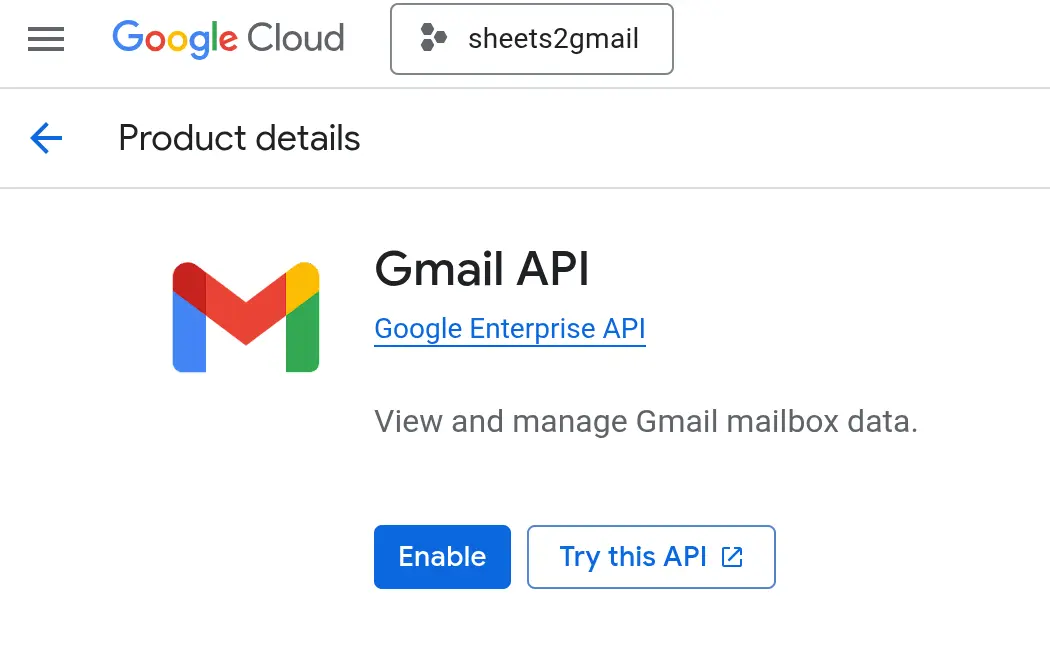
-
I set up the OAuth consent screen selecting the "External" audience:
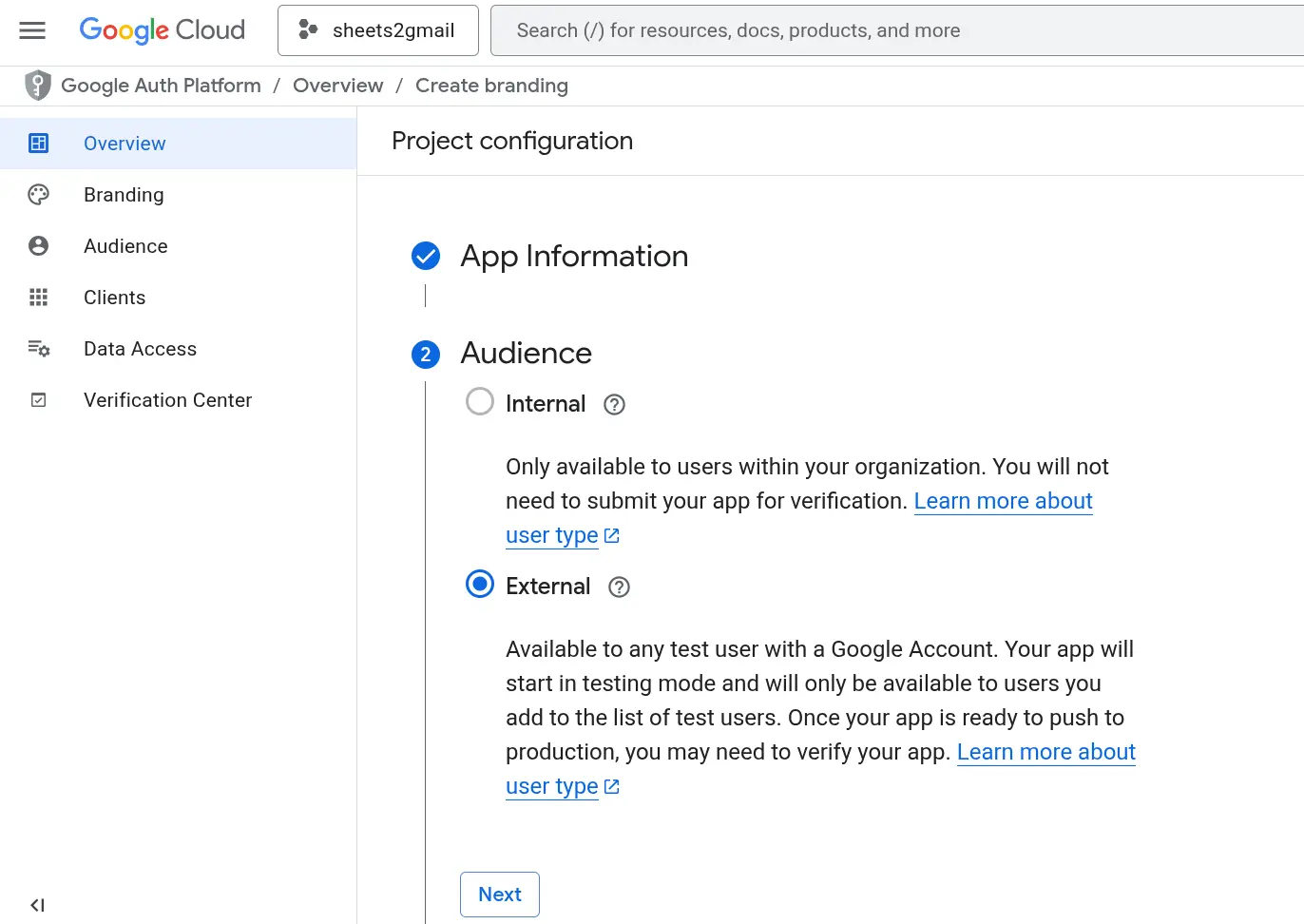
-
I added myself as a test user:
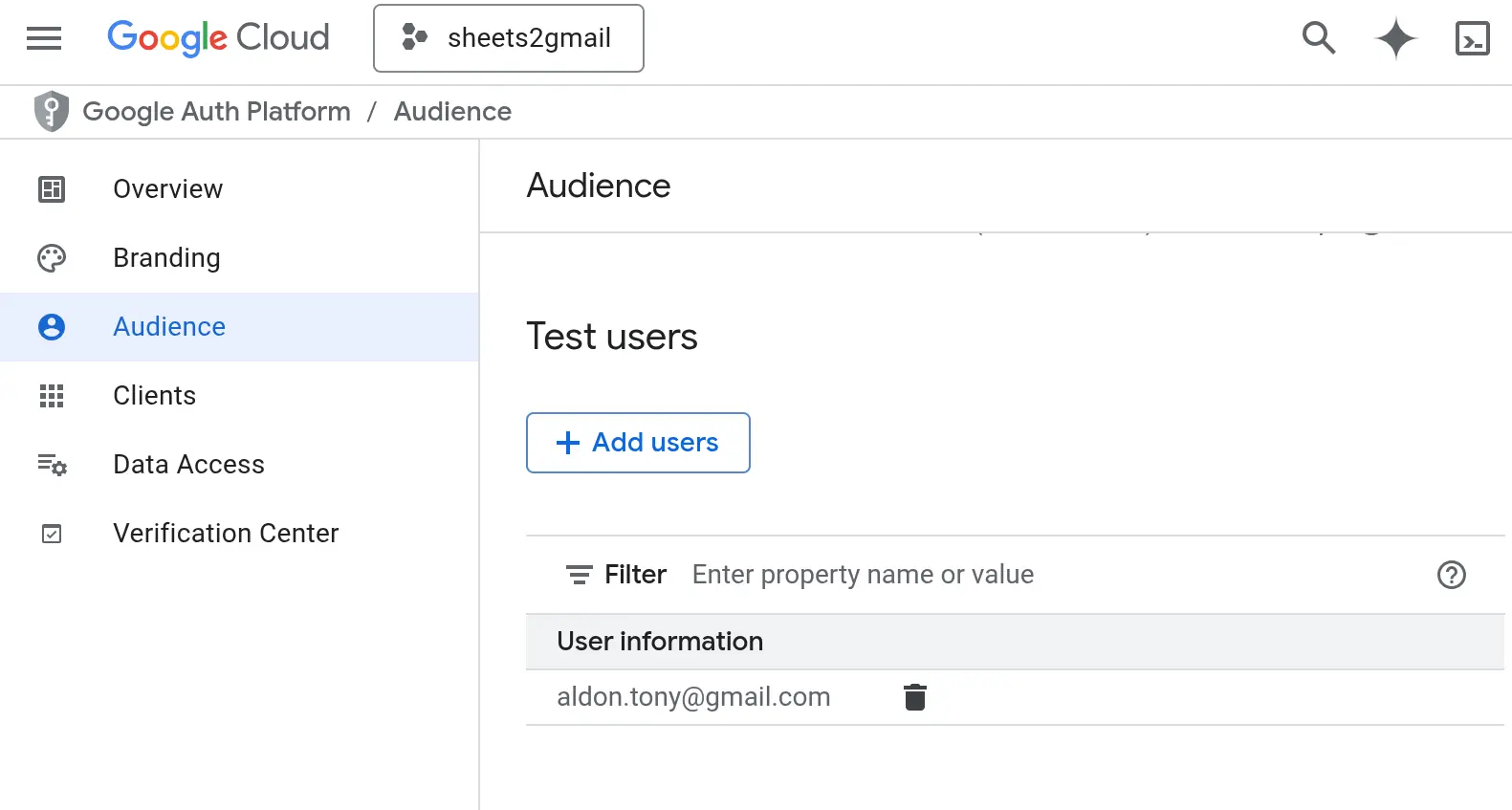
-
Then I created an OAuth client ID, downloaded it as a JSON file, and saved it my project directory as
credentials.json(right wheresheets2gmail_polling.pylives).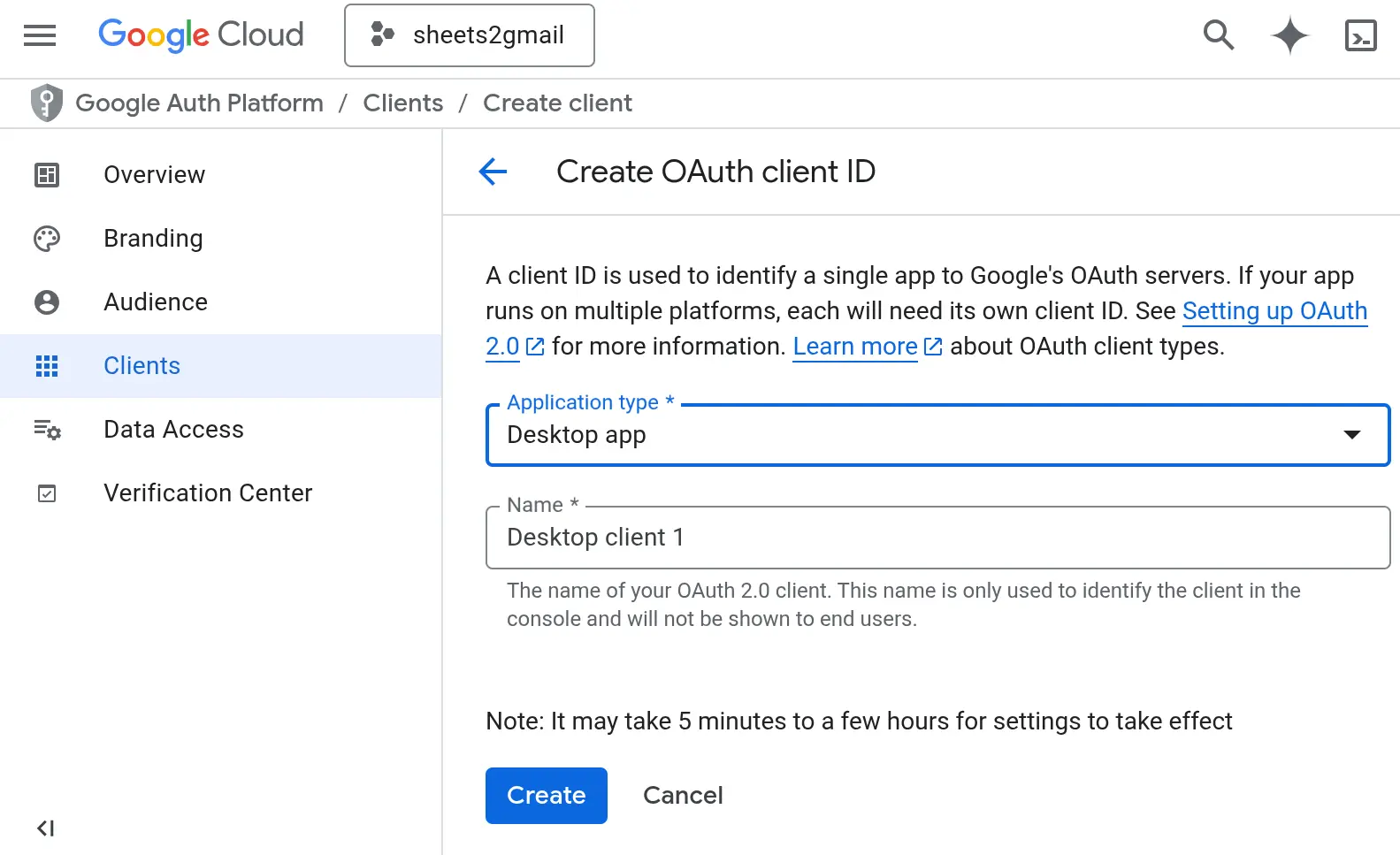
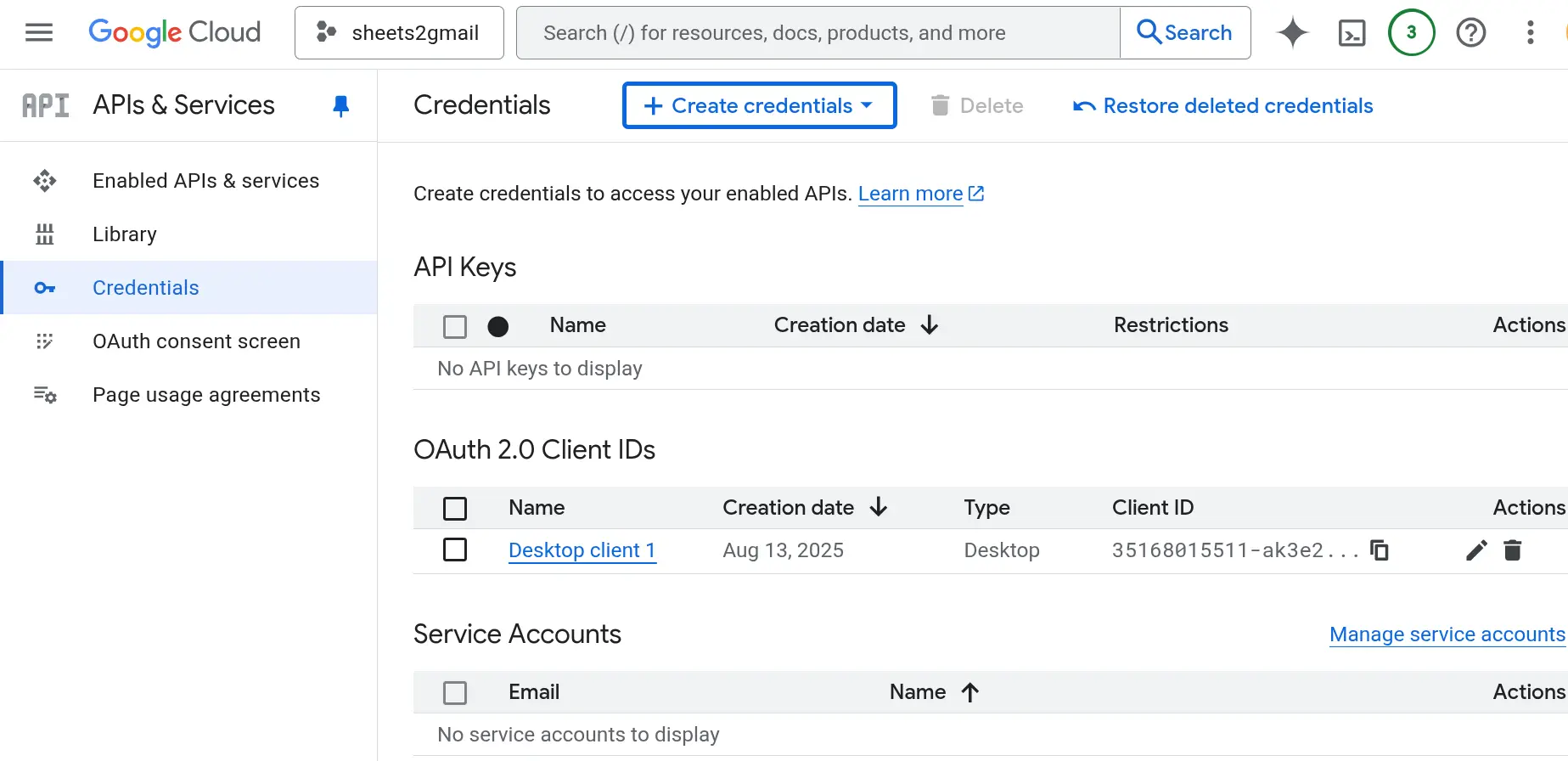
Note about the credentials
The credentials.json I
got after creating the OAuth client ID looks like this:
{
"installed": {
"client_id": "<some-id>.apps.googleusercontent.com",
"project_id": "sheets2gmail-468908",
"auth_uri": "https://accounts.google.com/o/oauth2/auth",
"token_uri": "https://oauth2.googleapis.com/token",
"auth_provider_x509_cert_url": "https://www.googleapis.com/oauth2/v1/certs",
"client_secret": "...",
"redirect_uris": [
"http://localhost"
]
}
}
The first time I ran
sheets2gmail_polling.py, it prompted me to authenticate and approve access for the
Google Sheets and Gmail APIs (according to the scopes in the
SCOPES variable):
SCOPES = ["https://www.googleapis.com/auth/spreadsheets.readonly",
"https://www.googleapis.com/auth/gmail.send"]
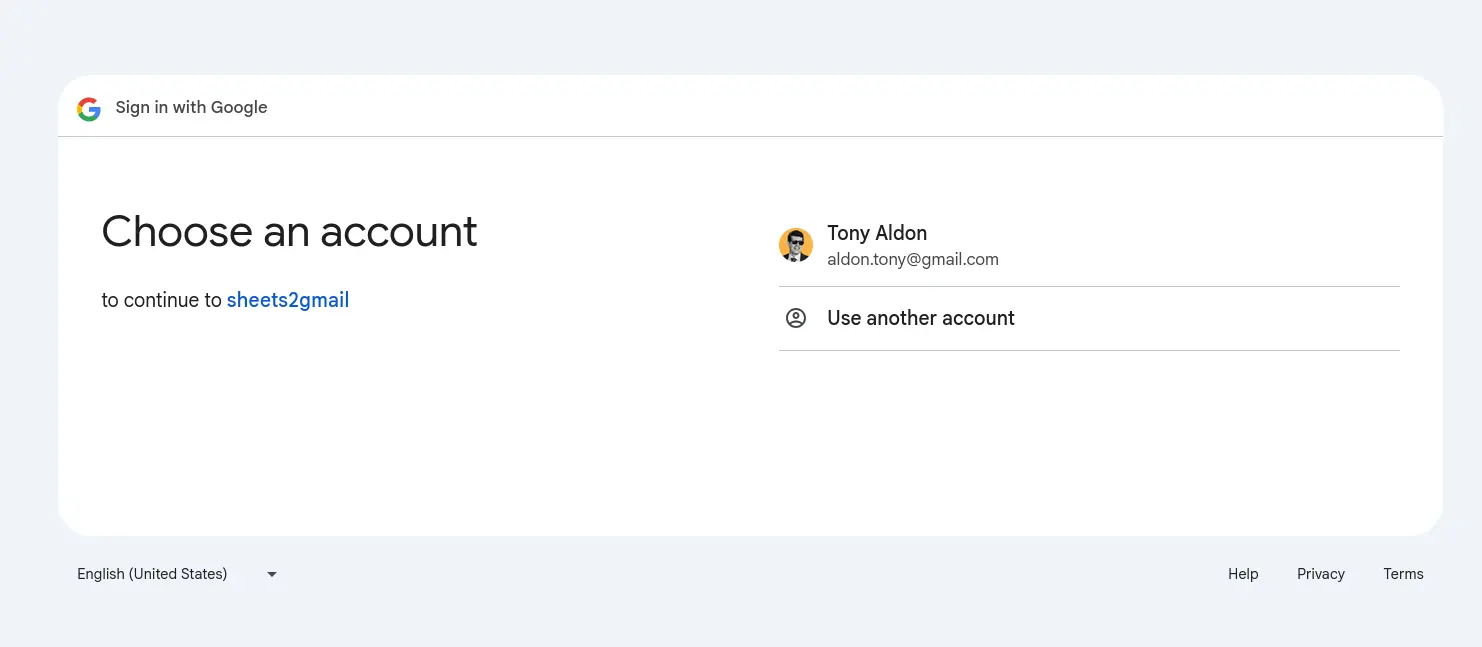
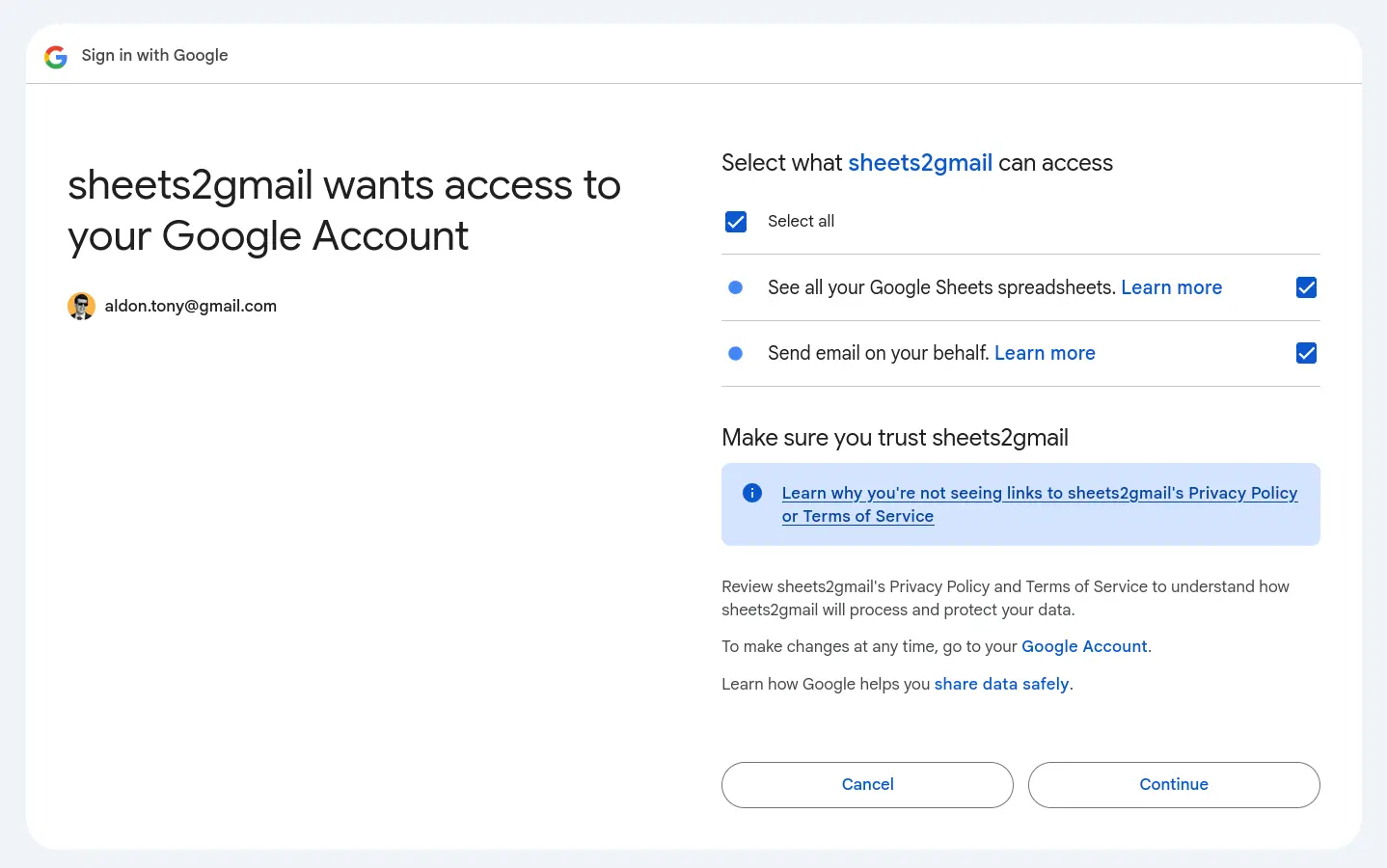
After authenticating, the script created a
token.json file. This
allows the script to reuse the credentials without prompting me
again, even after restarting.
The contents look something like this:
{
"token": "...",
"refresh_token": "...",
"token_uri": "https://oauth2.googleapis.com/token",
"client_id": "<some-id>.apps.googleusercontent.com",
"client_secret": "...",
"scopes": [
"https://www.googleapis.com/auth/spreadsheets.readonly",
"https://www.googleapis.com/auth/gmail.send"
],
"universe_domain": "googleapis.com",
"account": "",
"expiry": "2025-08-11T10:19:20Z"
}sheets2gmail_polling.py
If you want to try the script yourself:
-
Don't forget to create your own
credentials.json, as described above. -
Update these variables:
SPREADSHEET_ID,SHEET_NAME,FROM_ADDR. -
Optionally, adjust
POLLING_INTERVALif you want it to check more or less frequently.
$ uv init
$ uv add google-api-python-client google-auth-httplib2 google-auth-oauthlib
$ uv run sheets2gmail_polling.py# sheets2gmail_polling.py
import os.path
import hashlib
import sqlite3
import logging
import time
import base64
from email.message import EmailMessage
from google.auth.transport.requests import Request
from google.oauth2.credentials import Credentials
from google_auth_oauthlib.flow import InstalledAppFlow
from googleapiclient.discovery import build
from googleapiclient.errors import HttpError
logging.basicConfig(level=logging.INFO)
logger = logging.getLogger("sheets2gmail-polling")
# If modifying these scopes, delete the file token.json.
SCOPES = ["https://www.googleapis.com/auth/spreadsheets.readonly",
"https://www.googleapis.com/auth/gmail.send"]
CACHE_DB_FILE = "cache.sqlite3"
POLLING_INTERVAL = 60
SPREADSHEET_ID = "1EpC3YACK-OzTJzoonr-GRS-bEnxM5Qg9bDH9ltQFT3c"
SHEET_NAME = "Sheet1"
FROM_ADDR = "aldon.tony@gmail.com"
def credentials():
"""Get credentials from token.json file.
If not present or invalide, authenticate first using credentials.json file.
See https://developers.google.com/workspace/sheets/api/quickstart/python."""
creds = None
# The file token.json stores the user's access and refresh tokens,
# and is created automatically when the authorization flow completes
# for the first time.
if os.path.exists("token.json"):
creds = Credentials.from_authorized_user_file("token.json", SCOPES)
# If there are no (valid) credentials available, let the user log in.
if not creds or not creds.valid:
if creds and creds.expired and creds.refresh_token:
creds.refresh(Request())
else:
flow = InstalledAppFlow.from_client_secrets_file(
"credentials.json", SCOPES
)
creds = flow.run_local_server(port=0)
# Save the credentials for the next run
with open("token.json", "w") as token:
token.write(creds.to_json())
return creds
def hash_row(row):
"""Return a SHA256 hexdigest of `row`."""
s = '|'.join(str(x) for x in row)
return hashlib.sha256(s.encode()).hexdigest()
def get_rows(creds, spreadsheet_id, sheet_range):
"""Return list of rows in `sheet_range` of `spreadsheet_id`."""
with build("sheets", "v4", credentials=creds) as service:
response = (
service.spreadsheets()
.values()
.get(spreadsheetId=spreadsheet_id, range=sheet_range)
.execute()
)
return response.get("values")
def setup_cache_db(dbfile):
conn = sqlite3.connect(dbfile)
c = conn.cursor()
c.execute('''
CREATE TABLE IF NOT EXISTS cached_rows (
row_index INTEGER PRIMARY KEY,
row_hash TEXT
)
''')
c.execute('''
CREATE TABLE IF NOT EXISTS pending_emails (
id INTEGER PRIMARY KEY AUTOINCREMENT,
email TEXT,
note TEXT,
fail_count INTEGER DEFAULT 0
)
''')
conn.commit()
return conn
def check_rows(conn, rows):
"""Return the list of new or updated rows.
Elements are tuples (<state>, row_index, row_hash, row)
where <state> is \"new\" or \"updated\"."""
c = conn.cursor()
new_updated_rows = []
for idx, row in enumerate(rows[1:]):
# +1 because we don't pass the first row (column names) in rows
# +1 because Google Sheets start counting at 1
idx_sheet = idx + 2
h = hash_row(row)
c.execute("SELECT row_hash FROM cached_rows WHERE row_index=?", (idx_sheet,))
result = c.fetchone()
if result is None:
logger.info(f"Row {idx_sheet} is new: {row}")
new_updated_rows.append(("new", idx_sheet, h, row))
elif result[0] != h:
logger.info(f"Row {idx_sheet} has been updated: {row}")
new_updated_rows.append(("updated", idx_sheet, h, row))
logger.info(f"{len(new_updated_rows)} row(s) new/updated.")
return new_updated_rows
def update_cache(conn, new_updated_rows, sheet_row_count):
"""Update cached_rows table in `conn` listed in `new_updated_rows`.
Add `new_updated_rows` in pending_emails table in `conn`."""
c = conn.cursor()
for state, idx, h, row in new_updated_rows:
if state == "new":
c.execute("INSERT INTO cached_rows (row_index, row_hash) VALUES (?, ?)", (idx, h))
else:
c.execute("UPDATE cached_rows SET row_hash=? WHERE row_index=?", (h, idx))
if len(row) < 2 or row[1] == "":
logger.error(f"No email provided in row {idx}: {row}")
continue
if len(row) < 3 or row[2] == "":
logger.error(f"No note provided in row {idx}: {row}")
continue
c.execute("INSERT INTO pending_emails (email, note) VALUES (?, ?)", (row[1], row[2]))
c.execute("DELETE FROM cached_rows WHERE row_index > ?", (sheet_row_count,))
conn.commit()
def send_email(creds, from_addr, to, content):
"""Send email to `to` with content `content`."""
service = build("gmail", "v1", credentials=creds)
message = EmailMessage()
message["From"] = from_addr
message["To"] = to
message["Subject"] = "Automation Test"
message.set_content(content)
encoded_message = base64.urlsafe_b64encode(message.as_bytes()).decode()
body = {"raw": encoded_message}
send_message = (
service.users()
.messages()
.send(userId="me", body=body)
.execute()
)
return send_message["id"]
def send_emails(conn, creds, from_addr):
"""Send emails listed in pending_emails table in `conn`."""
c = conn.cursor()
c.execute("SELECT id, email, note FROM pending_emails WHERE fail_count < 3")
pending_emails = c.fetchall()
for email_id, to, content in pending_emails:
try:
msg_id = send_email(creds, from_addr, to, content)
logger.info(f"Email {msg_id} sent to {to}.")
c.execute("DELETE FROM pending_emails WHERE id = ?", (email_id,))
conn.commit()
except Exception as e:
logger.error(f"Failed to send to '{to}': {e}")
c.execute("UPDATE pending_emails SET fail_count = fail_count + 1 WHERE id = ?", (email_id,))
conn.commit()
c.execute("SELECT id, email, note FROM pending_emails WHERE fail_count = 3")
dead_emails = c.fetchall()
if dead_emails:
logger.warning(f"Some emails have failed to send after 3 attempts and remain in the `pending_emails` queue: {dead_emails}")
def main():
"""Track changes in `SPREADSHEET_ID`, specifically the sheet `SHEET_NAME`.
Each time a row in `SHEET_NAME` is updated, added or removed,
we send an email from `FROM_ADDR` to row[1] address with
row[2] as content. The subject is hardcoded to 'Automation Test'.
`SHEET_NAME` sheet must have the following shape:
name | email | note
foo | foo@example.com | foo note
bar | bar@example.com | bar note
baz | baz@example.com | baz note"""
conn = setup_cache_db(CACHE_DB_FILE)
creds = credentials()
# In case the program previously stopped before sending all the emails
send_emails(conn, creds, FROM_ADDR)
while True:
rows = get_rows(creds, SPREADSHEET_ID, SHEET_NAME)
if not rows or len(rows) == 1:
logger.info(f"No data in spreadsheet {SPREADSHEET_ID}, range {SHEET_NAME}")
else:
new_updated_rows = check_rows(conn, rows)
update_cache(conn, new_updated_rows, len(rows))
send_emails(conn, creds, FROM_ADDR)
time.sleep(POLLING_INTERVAL)
conn.close()
if __name__ == "__main__":
main()Getting an email by its message id
When an email is sent, the script logs its message ID like this:
INFO:sheets2gmail-polling:Email 1989d239d2c9ea33 sent to aldon.tony@gmail.com.
You can fetch the contents of a sent email by its ID using the
Gmail API, but you'll need to include the scope
"https://www.googleapis.com/auth/gmail.readonly".
For instance, for the message ID
1989d239d2c9ea33:
SCOPES = ["https://www.googleapis.com/auth/gmail.readonly"]
creds = credentials()
service = build("gmail", "v1", credentials=creds)
message = (
service.users()
.messages()
.get(userId="me", id="1989d239d2c9ea33")
.execute()
)
message
# {'id': '1989d239d2c9ea33', 'threadId': '1989d239d2c9ea33', 'labelIds': ['UNREAD', 'SENT', 'INBOX'], 'snippet': 'foo', 'payload': {'partId': '', 'mimeType': 'text/plain', 'filename': '', 'headers': [{'name': 'Received', 'value': 'from 636107077520 named unknown by gmailapi.google.com with HTTPREST; Tue, 12 Aug 2025 00:16:53 -0700'}, {'name': 'Received', 'value': 'from 636107077520 named unknown by gmailapi.google.com with HTTPREST; Tue, 12 Aug 2025 00:16:53 -0700'}, {'name': 'From', 'value': 'aldon.tony@gmail.com'}, {'name': 'To', 'value': 'aldon.tony@gmail.com'}, {'name': 'Subject', 'value': 'Automation Test'}, {'name': 'Content-Type', 'value': 'text/plain; charset="utf-8"'}, {'name': 'Content-Transfer-Encoding', 'value': '7bit'}, {'name': 'MIME-Version', 'value': '1.0'}, {'name': 'Date', 'value': 'Tue, 12 Aug 2025 00:16:53 -0700'}, {'name': 'Message-Id', 'value': '<CABiT0JALXNkSsGqetEO9OckoALcW4MD6tsS9nPEeeC4MwFGVFA@mail.gmail.com>'}], 'body': {'size': 4, 'data': 'Zm9vCg=='}}, 'sizeEstimate': 544, 'historyId': '5510829', 'internalDate': '1754983013000'}Here's the JSON, pretty-printed for readability:
{
"id": "1989d239d2c9ea33",
"threadId": "1989d239d2c9ea33",
"labelIds": [
"UNREAD",
"SENT",
"INBOX"
],
"snippet": "foo",
"payload": {
"partId": "",
"mimeType": "text/plain",
"filename": "",
"headers": [
{
"name": "Received",
"value": "from 636107077520 named unknown by gmailapi.google.com with HTTPREST; Tue, 12 Aug 2025 00:16:53 -0700"
},
{
"name": "Received",
"value": "from 636107077520 named unknown by gmailapi.google.com with HTTPREST; Tue, 12 Aug 2025 00:16:53 -0700"
},
{
"name": "From",
"value": "aldon.tony@gmail.com"
},
{
"name": "To",
"value": "aldon.tony@gmail.com"
},
{
"name": "Subject",
"value": "Automation Test"
},
{
"name": "Content-Type",
"value": "text/plain; charset=\"utf-8\""
},
{
"name": "Content-Transfer-Encoding",
"value": "7bit"
},
{
"name": "MIME-Version",
"value": "1.0"
},
{
"name": "Date",
"value": "Tue, 12 Aug 2025 00:16:53 -0700"
},
{
"name": "Message-Id",
"value": "<CABiT0JALXNkSsGqetEO9OckoALcW4MD6tsS9nPEeeC4MwFGVFA@mail.gmail.com>"
}
],
"body": {
"size": 4,
"data": "Zm9vCg=="
}
},
"sizeEstimate": 544,
"historyId": "5510829",
"internalDate": "1754983013000"
}Missing features & advantages in Zapier (according to gpt-4.1)
While I was writing the
sheets2gmail_polling.py
script, I started noticing what was missing—and
how much extra work would be needed—to reach
the level of professional automation that Zapier offers.
Naturally, I got curious, so when I finished the script, I asked
gpt-4.1 the following:
What is missing in the Python script compared to a Zap in Zapier.com that makes Zapier preferable?
This was the absolutely expected answer I received:
-
Instant Triggers: Zapier can use Google Drive's push notifications for near real-time updates, whereas your script is limited to polling on an interval (e.g., every 60 seconds or longer), which may not catch changes as quickly.
-
Error Handling and Notification: Zapier provides user-friendly error messages, built-in alerts, and automatic retries. If a step fails (e.g., missing required email address), it explains the error and notifies you immediately.
-
Monitoring, Logging, and Troubleshooting: Detailed run history, centralized logs, and a troubleshooting UI are built-in. You can see what happened in each Zap run, including data passed between steps and the exact reason for failure. Your script just logs messages to a file/console.
-
No-Code Editing: The workflow can be edited, tested, and expanded with a few clicks—no need to edit code or redeploy.
-
Built-in Authentication, Token Management, and Security: Zapier manages OAuth tokens and keeps them secure, handling refresh and expiration automatically.
-
Scalability and Reliability: Zapier is a managed platform—no worries about your server going down, system restarts, or losing state during updates.
-
UI for Workflow Management: Easy to enable/disable Zaps, manage multiple automations, see a dashboard, get system updates, and more—all through a graphical interface.
References
-
Google Cloud Console
-
google-api-python-client
-
Google Sheets API
-
Gmail API
-
https://developers.google.com/workspace/gmail/api/quickstart/python
-
https://developers.google.com/workspace/gmail/api/reference/rest/
-
https://developers.google.com/workspace/gmail/api/reference/rest/v1/users.messages/get
-
https://developers.google.com/workspace/gmail/api/reference/rest/v1/users.messages/send
-
https://developers.google.com/workspace/gmail/api/guides/sending#python
-
-
Google Drive API
My first Zapier Zap: Send emails via Gmail when Google Sheets rows are updated (part 1)
You're reading part 1 of My first Zapier Zap: Send emails via Gmail when Google Sheets rows are updated series, where I built an automation that send emails via Gmail when Google Sheets rows are updated:
-
Check out Part 2 to see how I built this automation in Python using a polling method. I check the Google Sheet for updates at regular intervals and sends the emails accordingly
Yesterday, I built and published my first Zapier Zap with the Zap editor.
The automation: Send emails via Gmail when Google Sheets rows are updated.
More precisely, for the "zapier test 1" Google
spreadsheet, whenever a row is added or updated in the
"Sheet1" sheet, send an email to the
email field. The content
of the email is taken from the
note field.
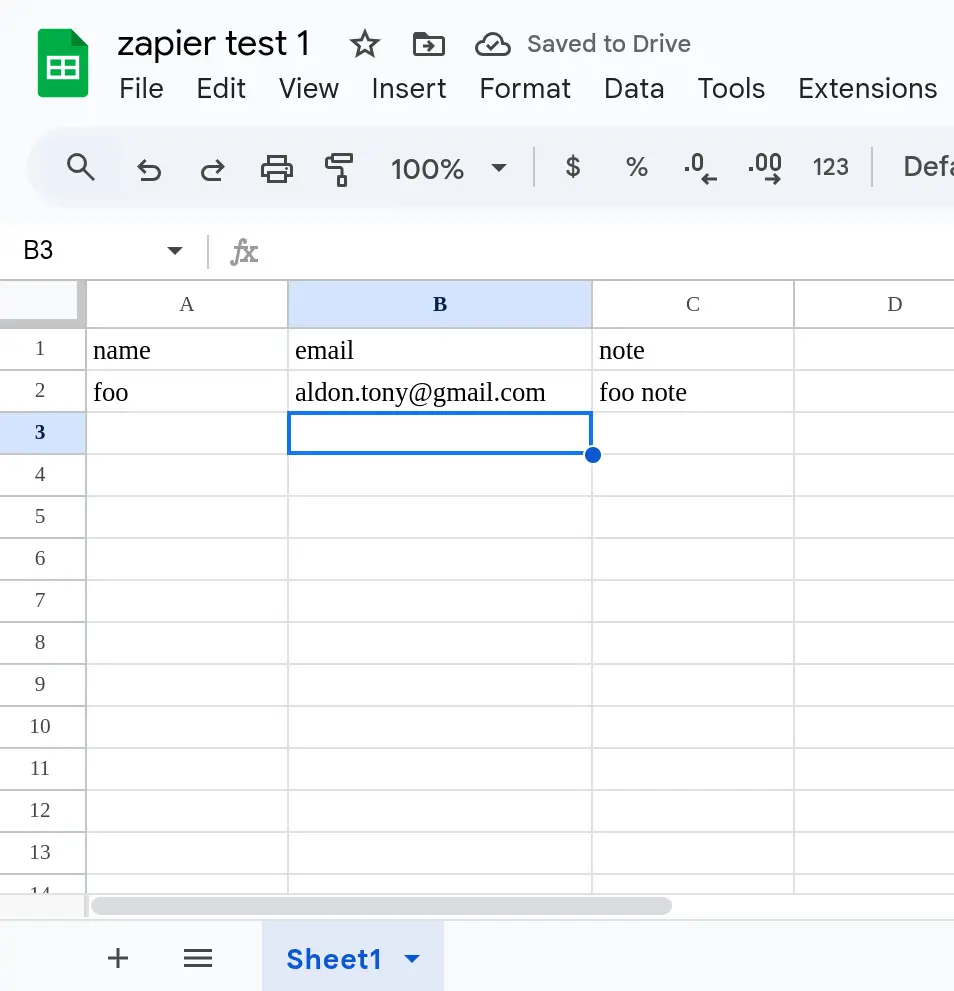
The user experience was smooth and quick.
Remember, a Zap is an automation made up of one trigger and one action. In other words: When this happens, do this.
Here are the steps I took:
-
I selected the Gmail app on https://zapier.com/apps/ page.
-
On the Gmail integrations page, I picked the Google Sheets app.
-
I requested more details about the automation: "Send emails via Gmail when Google Sheets rows are updated."
-
On the description page, I clicked "Try this template." That took me to the Zap editor with the Google Sheets trigger and Gmail action already selected.
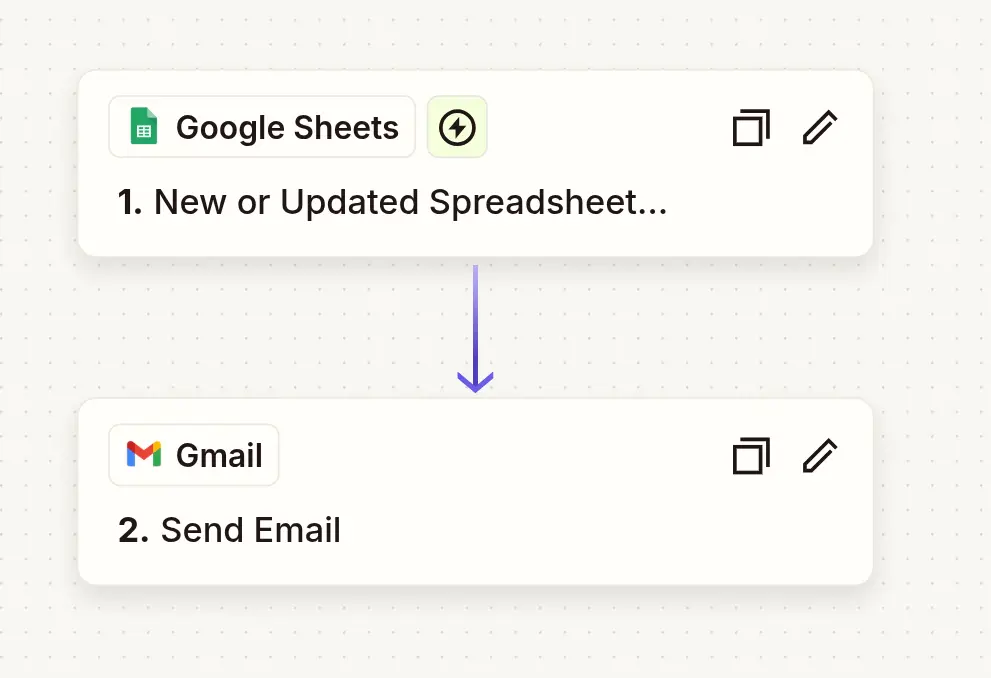
-
I authorized Zapier to access my Google Sheets, Google Drive and Gmail accounts.
-
I selected the "Sheet1" sheet in the "zapier test 1" spreadsheet and specified how to use the data to compose the email.
-
I ran the tests for the trigger and the action. Both worked.
-
Then I published the Zap.
Now comes an interesting part.
I wanted to see how this Zap behaves and how Zapier handles errors. How can I access the logs? Do they have logs? Are they insightful?
All of this matters because, when everything works, we live in a happy world. But when systems break, how can we troubleshoot? This is important, and it's better to think about it before a problem happens rather than after.
This is also what sets apart a product you can rely on from the rest.
So, here's what I did.
I added a row with the
name as "bar"
and left the other two fields empty, just to see what would happen:
Nothing, if the trigger requires a complete row or
-
An error, because the
emailandnotefields are required.
An error did happen, and I got notified by email: the
email and
note fields are required.
I could also see the error logged in
Zap history:
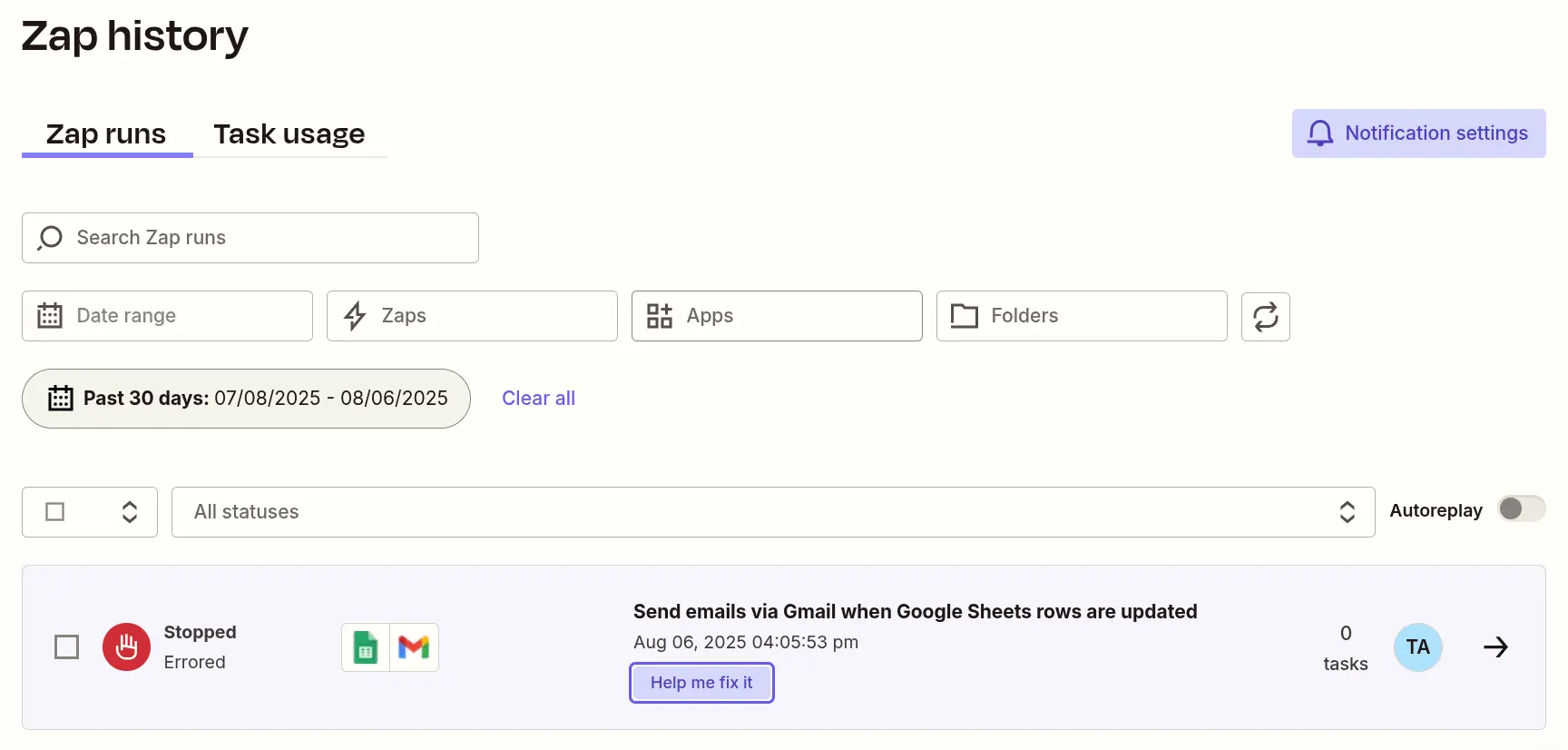
Something cool is that I could troubleshoot the error by
looking at the corresponding Zap run (016eba4d-4db5-ae11-a121-210f174f6081) at the Zap editor:
This Gmail step hit an error
Required field "body" (body) is missing.
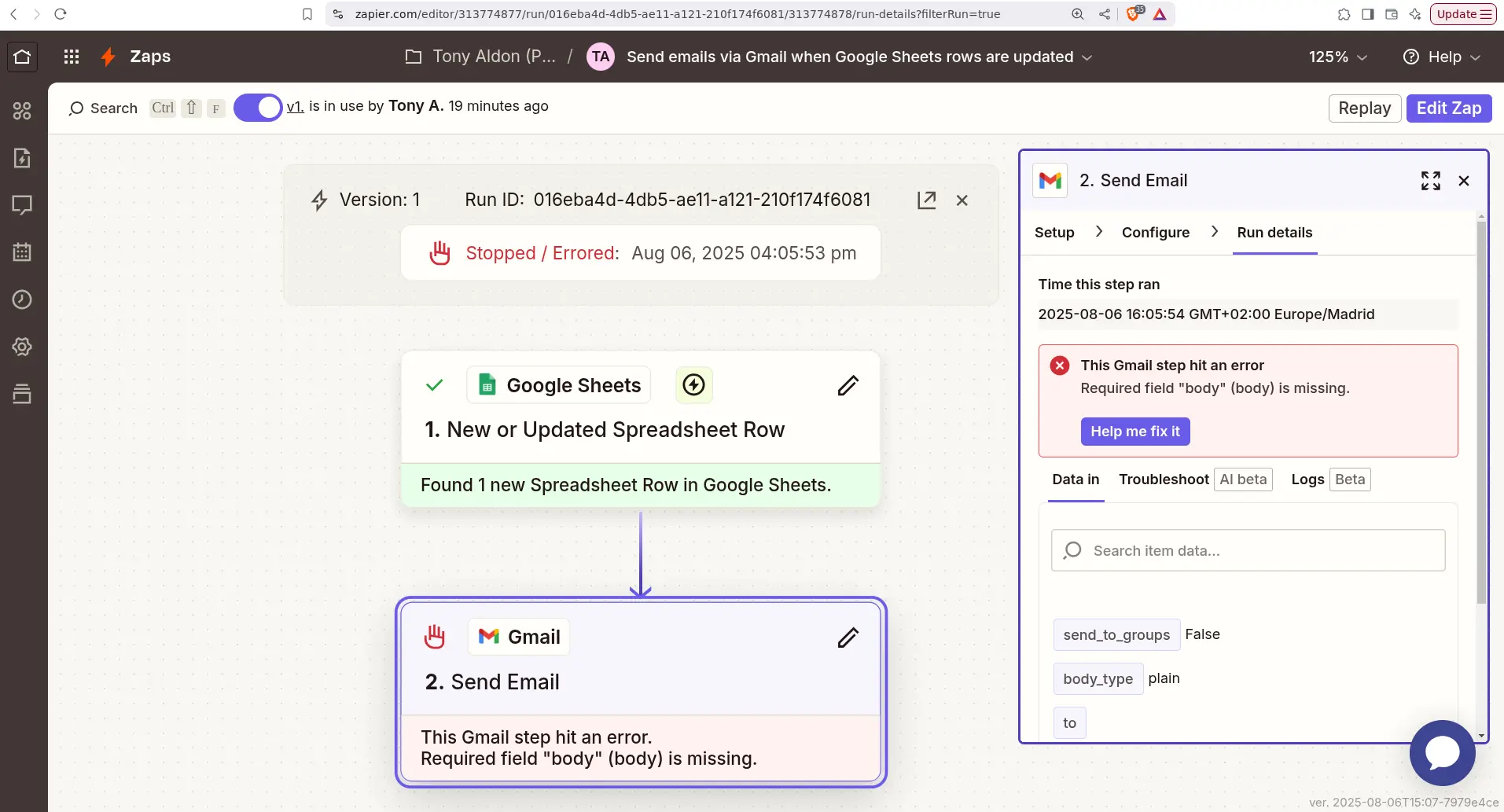
In the Zap editor, I clicked on the "Troubleshoot" tab to get AI-generated details about my error:
What this error means:
The error indicates that the Zap is trying to use data from a previous step, specifically the "to" and "body" fields, but it appears that the expected values were not passed correctly. This could be due to the previous step not outputting the necessary data or the data being in an unexpected format.
How to fix it:
Check Previous Step Output: Review the output of the previous step (Google Sheets) to ensure that it contains the expected values for "COL$B" (recipient email) and "COL$C" (email body).
Verify Data Mapping: Ensure that the fields in the Gmail action are correctly mapped to the outputs from the Google Sheets step. The "to" field should map to the email address and the "body" field should map to the email content.
Use Formatter Step: If the data needs to be extracted or formatted, consider adding a Formatter step before the Gmail action to ensure the data is in the correct format.
Test the Zap: After making adjustments, test the Zap to confirm that the email sends successfully with the correct data.
For more info check out:
How to automatically extract data from your apps to use in your Zaps
Common Problems with Gmail on Zapier
What HTML tags are supported in Gmail?
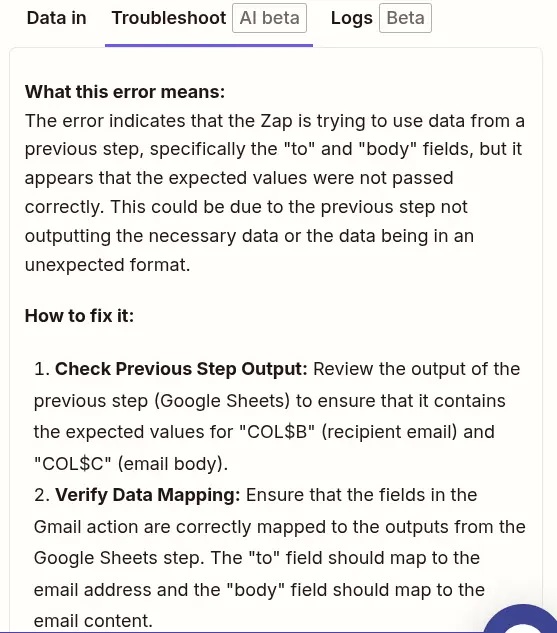
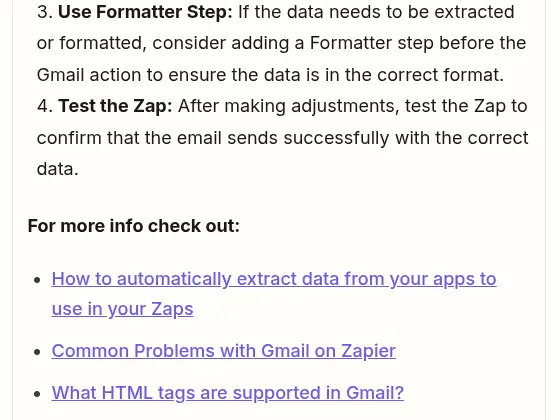
In cases where the error isn't due to missing required information (like in my case), you can access the Zap's HTTP log under the "Logs" tab.
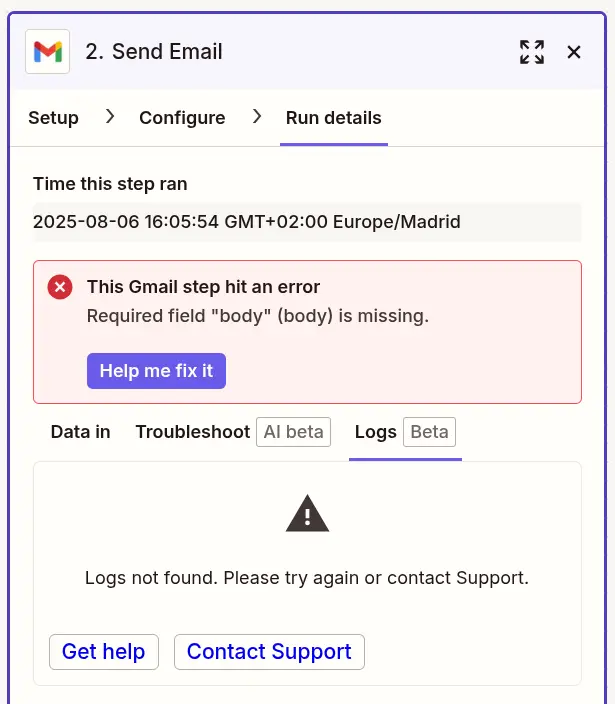
For more troubleshooting tips on Zap errors, check this out: https://help.zapier.com/hc/en-us/articles/8496037690637-How-to-troubleshoot-errors-in-Zaps
Everything worked well when I filled in a row completely with the expected fields.
Cool first experience with Zapier. Automation made easy.
That's all I have for today! Talk to you soon ;)
Automation is removing human intervention from systems
Yesterday, I read the first five articles of Top 10 AI automation articles from Zapier's blog in 2025, all written by Elena Alston.
These articles are packed with a tremendous number of AI automation examples. They make you think: AI automation will be everywhere, and that's truly exciting.
In Why pairing AI with automation will change how you work I found my favorite example:
Picture this:
You attend a call with a potential prospect who shows interest in your product.
After you hang up, AI sifts through the conversation, pulling out key details like:
pain points and
specific needs.
The information is then automatically logged in your CRM.
A personalized outreach email is drafted based on the lead's preferences and behavior.
Your sales team in Slack receives a notification.
Finally the right team member can trigger the outreach.
Quite compelling AI automation, and beautiful at the same time. Right?
Looking at these real-world applications, I realized something important about AI automation engineering. The real value —and difficulty— lies not so much in how to automate, but in what you choose to automate with AI.
You add value not just by building AI automation solutions, but because you know which parts of a business process can and should be automated with AI.
I used to think automation just meant using technology to handle repetitive tasks instead of people. But it's more than that. I looked up the definition of "automation," and found this (according to Perplexity):
Automation is the use of technology to perform tasks with minimal or no human intervention, typically by making processes, systems, or apparatuses operate automatically. Automation is achieved using a range of technologies—including software, robotics, machines, and control systems—to monitor, control, and execute activities faster, more efficiently, and with fewer errors than manual processes.
To make it easier for myself, I'll define it simply as:
Automation is removing human intervention from systems.
Another point I hadn't considered before: automation is especially valuable for tasks prone to human error. Think of:
Data entry
Invoice processing and payment
Scheduling and calendar management
Email sorting and responses
Data backup
etc.
I'll definitely keep this in mind.
Thanks to Elena for these insightful articles.
Previous posts
Built with one.el.
